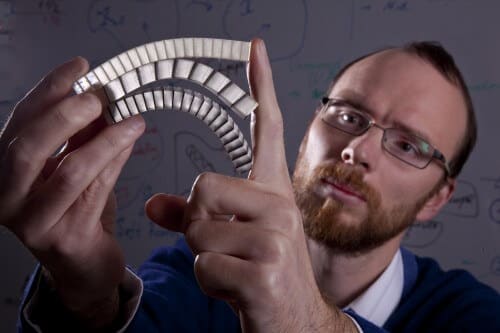Uniforms that function as PPE, and astronaut suits that are flexible but resistant to particle impact, are two of the possible applications for new composite materials developed at the Technion

Bulletproof uniforms, and astronaut suits resistant to micrometeorites, are two of the possible applications for new materials developed in the Faculty of Aeronautics and Space Engineering at the Technion. This is reported by Soft Matter magazine. These materials were developed by Associate Professor Stefan Rudich, a faculty member. According to him, "Flexibility and strength are seen as two opposite qualities, that as you increase one of them, you lose from the other. In general this is true, but in my research I try to create materials that will be flexible and yet strong (in terms of permeability)."
Associate Professor Stefan Rodich specializes in the creation of soft composite materials - a specific branch of materials engineering. He started his career as a theoretician, but the exposure to the world of XNUMXD printing - in his post-doctorate at MIT - brought him closer to the experimental world. "Suddenly I could produce the materials I design," he says, "and then check if their properties match my theoretical prediction. Even now, with these materials that are flexible but relatively resistant to penetration, I can experiment with the models I print." He collaborates with MIT even today, and in the current research.
Associate Professor Rodich came to the Technion as a faculty member straight from his post-doc. His research has already been published in leading journals, for example Physical Review Letters. The new article is published in Soft Matter. "The better we understand the relationship between the molecular structure of the material and its properties at the macro level, the better we control the functions we 'extract' from it - wavelengths, flexibility, electric current, etc.," he explains. He develops the new flexible-strong materials inspired by the fish. "The fish is a flexible creature, yet it is protected by hard scales. Its 'secret' is the combination between the scales and the soft tissue underneath, and that's what I tried to imitate here. The materials I design are also made up of two layers - one soft ('the body') and another ('scales') which is the 'armour'. This is how the same integrated feature (protecto-flexibility) that interests us is achieved."
When asked about possible applications, he speaks very cautiously. "My job is not to develop applications but to design the material itself, and my focus right now is the optimization of the material. If we are still talking about an application, for example about flexible astronaut suits that are resistant to being hit by particles (micro-meteors), then certain areas of the fabric (the chest area) do not require flexibility, which is very essential in other areas such as the elbow."
It is important for him to clarify that the contrast between flexibility and strength cannot be completely eliminated, but it is possible to 'play' with the interrelationship between them - the trade off. "I was able to increase the strength of the material 40 times, and at the same time reduce the flexibility only 5 times, and this opens up a lot of possibilities. If we talk about uniforms, the idea is to create a custom-designed texture (tailored), according to the body structure of the user and of course according to the conditions expected of him. In case radiation protection is required, a filter layer can be added."
He is currently testing 'his' materials in static tests, that is, by slowly pressing a rod. In the future, he hopes to reach dynamic tests, that is, of objects that will hit the material quickly - such as a projectile or a micro-meteorite - and examine the results.
